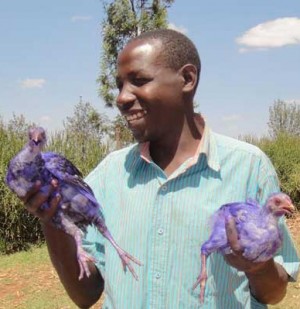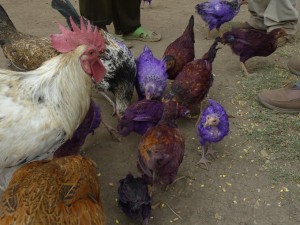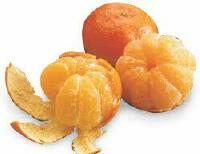 DNA capacity activation is all about activating the resources of hidden and dormant in your DNA… capacities that mean the difference between a so-so life, and a good life, like resourcefulness and seeing the big picture.
DNA capacity activation is all about activating the resources of hidden and dormant in your DNA… capacities that mean the difference between a so-so life, and a good life, like resourcefulness and seeing the big picture.
All of the capacities are attitudes and emotional abilities… how you do things, not what you do.
Here is an article I saw that shows a good example or decision-making that uses capacities most people need but don’t have:
The “Purple Chick” strategy:
So what can chicken farmers in the rural district of Nakuru, in Kenya, teach us about resourcefulness?
Well it’s like this:
If you’re a chicken farmer in Nakuru, Kenya, the most vulnerable time for your hatchlings is the first 10 weeks.
There are two dangers to the chicks:
DANGER 1: Disease (it costs about five Kenyan shillings to vaccinate the chicks against disease).
DANGER 2: Eagles and hawks. The birds of prey swoop down and… GULP… there goes another chick!
Thus a conundrum presents itself:
Why pay to vaccinate the chicks if birds of prey are going to swoop down and kill them anyway?
Believe it or not, the solution turned out to be incredibly simple:
PAINT THE CHICKS PURPLE.
 For some reason birds of prey do not fancy lunching on purple chicks… and so they leave them alone (I think it has something to do with the birds of prey not realizing the chicks are in fact chicks if they are painted purple; like you or I hesitating to eat mashed potato if it were colored green!).
For some reason birds of prey do not fancy lunching on purple chicks… and so they leave them alone (I think it has something to do with the birds of prey not realizing the chicks are in fact chicks if they are painted purple; like you or I hesitating to eat mashed potato if it were colored green!).
Anyway, so they started painting the chicks in a biodegradable purple paint which washes off in ten weeks — by which time the chicks have found their “running legs” and can dart for cover every time a bird of prey hovers overhead.
And because the Kenyan farmers are now losing far fewer chicks to birds of prey — it makes sense to vaccinate the chicks (against disease) as well.
Through both those measures (painting the chicks purple, and vaccinating them) the Kenyan chicken farmers have gone from a survival rate of 20 percent to close to 85 percent.
So Kenyan chicken farmers are able to sell more chickens, and thus, can afford to vaccinate hatchlings against disease.
Another interesting thing has happened:
Because more chicks are surviving and maturing into adult chickens — the Kenyan farmers are eating more chicken, getting better nutrition (specifically protein) for themselves and their families.
More Kenyans are taking up chicken farming, too.
All because of PURPLE CHICKS!
And get this:
Because of the above, an entirely new profession has also sprung up in rural Kenya: Chicken Painters! (apparently they charge three Kenyan shillings to paint each chick).
I don’t know about you — but I like the purple chick story. Lots of good resourcefulness on show in it!
And as you’re probably aware, resourcefulness, seeing the big picture and “thinking outside of the box” are key capacities I can activate.
Another way this article is relevant is this: Dark Side, and the people in your life don’t want you to have more capacities. People with more capacities are hard to control… and people want to control you.
Your job is to play the purple chick strategy: and say nothing, show nothing of your efforts to master a new capacity… or they will kill it… as sure as that night comes after day.
I have seen it again and again and again: people in my students lives killing the hatchling of a capacity, before it could walk on its own.
If you have no new capacities? This is a great story of inventiveness…

I have no idea. search google.
thank u 4 this leakage, bt hw can i get the paint
Happy New Year Sophie! I just came home from spending the year end holiday with my parents and family. Thank you for sharing this interesting story! It’s amazing how a creative idea can solve a big problem if the idea hits the sweet spot of the problem.
Nice long holiday… Yes, I shared the story because I liked it.